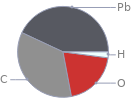Input interpretation

lead(II) salicylate | elemental composition
Result

Find the elemental composition for lead(II) salicylate in terms of the atom and mass percents: atom percent = N_i/N_atoms × 100% mass percent = (N_im_i)/m × 100% Plan: • Write the chemical formula and gather atomic masses from the periodic table. • Determine values for N_i, m_i, N_atoms and m using these items. • Finally, compute the percents and check the results. Write the chemical formula: Pb(OCOC_6H_4OH)_2 Use the chemical formula, Pb(OCOC_6H_4OH)_2, to count the number of atoms, N_i, for each element and find the total number of atoms, N_atoms: | number of atoms C (carbon) | 14 H (hydrogen) | 10 O (oxygen) | 6 Pb (lead) | 1 N_atoms = 14 + 10 + 6 + 1 = 31 Divide each N_i by N_atoms to calculate atom fractions. Then use the property that atom fractions must sum to one to check the work: | number of atoms | atom fraction C (carbon) | 14 | 14/31 H (hydrogen) | 10 | 10/31 O (oxygen) | 6 | 6/31 Pb (lead) | 1 | 1/31 Check: 14/31 + 10/31 + 6/31 + 1/31 = 1 Compute atom percents using the atom fractions: | number of atoms | atom percent C (carbon) | 14 | 14/31 × 100% = 45.2% H (hydrogen) | 10 | 10/31 × 100% = 32.3% O (oxygen) | 6 | 6/31 × 100% = 19.4% Pb (lead) | 1 | 1/31 × 100% = 3.23% Look up the atomic mass, m_i, in unified atomic mass units, u, for each element in the periodic table: | number of atoms | atom percent | atomic mass/u C (carbon) | 14 | 45.2% | 12.011 H (hydrogen) | 10 | 32.3% | 1.008 O (oxygen) | 6 | 19.4% | 15.999 Pb (lead) | 1 | 3.23% | 207.2 Multiply N_i by m_i to compute the mass for each element. Then sum those values to compute the molecular mass, m: | number of atoms | atom percent | atomic mass/u | mass/u C (carbon) | 14 | 45.2% | 12.011 | 14 × 12.011 = 168.154 H (hydrogen) | 10 | 32.3% | 1.008 | 10 × 1.008 = 10.080 O (oxygen) | 6 | 19.4% | 15.999 | 6 × 15.999 = 95.994 Pb (lead) | 1 | 3.23% | 207.2 | 1 × 207.2 = 207.2 m = 168.154 u + 10.080 u + 95.994 u + 207.2 u = 481.428 u Divide the mass for each element by m to calculate mass fractions. Then use the property that mass fractions must sum to one to check the work: | number of atoms | atom percent | mass fraction C (carbon) | 14 | 45.2% | 168.154/481.428 H (hydrogen) | 10 | 32.3% | 10.080/481.428 O (oxygen) | 6 | 19.4% | 95.994/481.428 Pb (lead) | 1 | 3.23% | 207.2/481.428 Check: 168.154/481.428 + 10.080/481.428 + 95.994/481.428 + 207.2/481.428 = 1 Compute mass percents using the mass fractions: Answer: | | | number of atoms | atom percent | mass percent C (carbon) | 14 | 45.2% | 168.154/481.428 × 100% = 34.93% H (hydrogen) | 10 | 32.3% | 10.080/481.428 × 100% = 2.094% O (oxygen) | 6 | 19.4% | 95.994/481.428 × 100% = 19.94% Pb (lead) | 1 | 3.23% | 207.2/481.428 × 100% = 43.04%
Mass fraction pie chart

Mass fraction pie chart